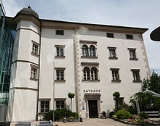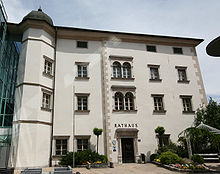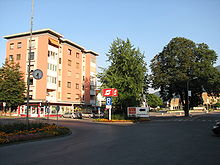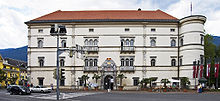
Spittal an der Drau
Encyclopedia
Spittal an der Drau is located in the western part of the Austria
n federal state of Carinthia
and the administrative centre of the federal state's second largest district, Spittal an der Drau
. It lies between the Lurnfeld
area and the Lower Drava
Valley. The city consists of the seven Katastralgemeinden Amlach, Edling, Großegg, Molzbichl, Olsach, Spittal and St. Peter-Edling. It formally received town privileges
in 1930.
Despite its name the historic core of Spittal originated on the banks of the small Lieser River, which flows into the Drava in the south of the city. Within the subdivision of Großegg the area of Spittal extends to the southern shore of Lake Millstatt.


, when the Counts Hermann I and Otto II of Ortenburg
had a hospital (Spittl) with a chapel built where the ancient road leading to the Katschberg Pass
crossed the Lieser river. Together with the Ortenburg estates, Spittal in 1418 was inherited by Count Hermann II of Celje. The Counts of Celje
, raised to immediate Reichsgrafen in 1436, became extinct when Count Ulrich II
was killed by the liegemen of László Hunyadi
in 1456, after which Emperor Frederick III of Habsburg
seized his territory and incorporated it into the Duchy of Carinthia
.
The Ortenburg counts had granted Spittal the rights of a market town
in 1242, while in 1457 the citizen were given the right to choose their own judge and the council. Shortly after the town and the surrounding lands were, however, devastated by Turkish
warriors and the troops of Emperor Frederick's long-time rival King Matthias Corvinus of Hungary
. Ravaged by a peasant's revolt and two fires in 1522 and 1729, the decline continued, until in 1524 Archduke Ferdinand I of Austria
entrusted his treasurer Gabriel von Salamanca
(1489–1539) with the former Ortenburg county. From his descendants the estates passed to the Gorizian
Counts of Porcia in 1662.

 In the town centre is Schloss Porcia
In the town centre is Schloss Porcia
, considered one of the most important Renaissance
castles in Austria. Built from 1533 on by Gabriel von Salamanca-Ortenburg, the castle in the style of an Italian palazzo
from 1662 till 1918 was a residence of the Counts of Porcia. Today it hosts an annual festival for classic theatrical comedies
(Komödienspiele Porcia) and is also home of a museum of local history
.
Opposite is the town hall, a former Renaissance Palais of the Khevenhüller noble family, built in 1537.
The late Gothic
Catholic
parish church Mary's Annunciation
was built in 1584 upon foundations of the 13th century.
The Spittl (hospital), from which the city derived its name, was rebuilt by Gabriel von Salamanca in the 16th century at the bridge crossing over the Lieser river. In 1919 during the occupation of Lower Carinthia
by troops of the Kingdom of Yugoslavia
it served as the provisional seat of the Carinthian government. Since 1995 the Spittl has been a seat of the Carinthian Fachhochschule
(University of Applied Sciences) for Engineering
("Technikum").
East of the town, within the Drava Valley lies the village of Molzbichl, which is home to the remains of Carinthia's first monastery
, established about 780 by Duke Tassilo III of Bavaria
and abandoned in the 10th century. A small museum nearby shows several artifacts
of Carolingian
origin. The foundation of the monastery church is visible south of the present parish church Saint Tiburtius
, which itself has an altar including a Roman
tombstone of an Early Christian
deacon
Nonnosus
, who died here in 532.
On a slope above the valley, northeast of the town is Schloss Rothenthurn, in the 11th century the "Red Tower" ("Roter Turm"), a fiefdom of the Counts of Ortenburg. The present-day palace is a building from the 17th century and serves as a hotel.
Spittal is home of Austria's largest private collection of model railroads
.
to Salzburg
. It lies also near the A10 Tauern Autobahn
as well as on the Bundesstraße
n highways B99 Katschberg-Straße leading to the Katschberg Pass
and the B100 Drautal-Straße to Lienz
in East Tyrol
. A cableway runs up to Mount Goldeck (2,142 m).
, Germany
(1973) Pordenone
, Italy
(1987) Porcia, Italy
(1987)
Austria
Austria , officially the Republic of Austria , is a landlocked country of roughly 8.4 million people in Central Europe. It is bordered by the Czech Republic and Germany to the north, Slovakia and Hungary to the east, Slovenia and Italy to the south, and Switzerland and Liechtenstein to the...
n federal state of Carinthia
Carinthia (state)
Carinthia is the southernmost Austrian state or Land. Situated within the Eastern Alps it is chiefly noted for its mountains and lakes.The main language is German. Its regional dialects belong to the Southern Austro-Bavarian group...
and the administrative centre of the federal state's second largest district, Spittal an der Drau
Spittal an der Drau (district)
The Bezirk Spittal an der Drau is an administrative district in Carinthia, Austria.Area of the district is 2,763.99 km², population is 81,719 , and population density 30 persons per km². It is Austria's second largest district by area...
. It lies between the Lurnfeld
Lurnfeld
Lurnfeld is a market town in the district of Spittal an der Drau in the Austrian state of Carinthia. The municipality consists of the two Katastralgemeinden Möllbrücke and Pusarnitz....
area and the Lower Drava
Drava
Drava or Drave is a river in southern Central Europe, a tributary of the Danube. It sources in Toblach/Dobbiaco, Italy, and flows east through East Tirol and Carinthia in Austria, into Slovenia , and then southeast, passing through Croatia and forming most of the border between Croatia and...
Valley. The city consists of the seven Katastralgemeinden Amlach, Edling, Großegg, Molzbichl, Olsach, Spittal and St. Peter-Edling. It formally received town privileges
Town privileges
Town privileges or city rights were important features of European towns during most of the second millennium.Judicially, a town was distinguished from the surrounding land by means of a charter from the ruling monarch that defined its privileges and laws. Common privileges were related to trading...
in 1930.
Despite its name the historic core of Spittal originated on the banks of the small Lieser River, which flows into the Drava in the south of the city. Within the subdivision of Großegg the area of Spittal extends to the southern shore of Lake Millstatt.


History
The settlement was first mentioned in a 1191 deed issued by Archbishop Adalbert III Přemysl (Vojtech) of SalzburgArchbishopric of Salzburg
The Archbishopric of Salzburg was an ecclesiastical State of the Holy Roman Empire, its territory roughly congruent with the present-day Austrian state of Salzburg....
, when the Counts Hermann I and Otto II of Ortenburg
Grafschaft Ortenburg
The Ortenburger were a medieval noble family in the Duchy of Carinthia, with roots in Bavarian nobility. An affiliation with the Counts of Ortenburg-Neuortenburg, a branch line of the Rhenish Franconian House of Sponheim, is not established. Little is known about their reasons for settlement in...
had a hospital (Spittl) with a chapel built where the ancient road leading to the Katschberg Pass
Katschberg Pass
Katschberg Pass is a high mountain pass in the Central Eastern Alps in Austria between Rennweg am Katschberg in the state of Carinthia and Sankt Michael im Lungau in Salzburg....
crossed the Lieser river. Together with the Ortenburg estates, Spittal in 1418 was inherited by Count Hermann II of Celje. The Counts of Celje
Counts of Celje
The Counts of Cilli or Celje represent the most important medieval aristocratic and ruling house with roots and territory in present-day Slovenia....
, raised to immediate Reichsgrafen in 1436, became extinct when Count Ulrich II
Ulrich II of Celje
Ulrich II , also known as Ulrich Cillei, was the last Princely Count of Celje.Ulrich II. was the son of Count Frederick II of Celje and his wife Elizabeth, a scion of the Croatian House of Frankopan. Little is known of his youth...
was killed by the liegemen of László Hunyadi
László Hunyadi
Ladislaus Hunyadi or László Hunyadi was a Hungarian statesman.Ladislaus Hunyadi was the elder of the two sons of John Hunyadi, voivode of Transylvania and later regent of the Kingdom of Hungary, and Elizabeth Szilágyi. He was the older brother of Matthias Hunyadi, who would later became the king...
in 1456, after which Emperor Frederick III of Habsburg
Frederick III, Holy Roman Emperor
Frederick the Peaceful KG was Duke of Austria as Frederick V from 1424, the successor of Albert II as German King as Frederick IV from 1440, and Holy Roman Emperor as Frederick III from 1452...
seized his territory and incorporated it into the Duchy of Carinthia
Duchy of Carinthia
The Duchy of Carinthia was a duchy located in southern Austria and parts of northern Slovenia. It was separated from the Duchy of Bavaria in 976, then the first newly created Imperial State beside the original German stem duchies....
.
The Ortenburg counts had granted Spittal the rights of a market town
Market town
Market town or market right is a legal term, originating in the medieval period, for a European settlement that has the right to host markets, distinguishing it from a village and city...
in 1242, while in 1457 the citizen were given the right to choose their own judge and the council. Shortly after the town and the surrounding lands were, however, devastated by Turkish
Ottoman Empire
The Ottoman EmpireIt was usually referred to as the "Ottoman Empire", the "Turkish Empire", the "Ottoman Caliphate" or more commonly "Turkey" by its contemporaries...
warriors and the troops of Emperor Frederick's long-time rival King Matthias Corvinus of Hungary
Matthias Corvinus of Hungary
Matthias Corvinus , also called the Just in folk tales, was King of Hungary and Croatia from 1458, at the age of 14 until his death...
. Ravaged by a peasant's revolt and two fires in 1522 and 1729, the decline continued, until in 1524 Archduke Ferdinand I of Austria
Ferdinand I, Holy Roman Emperor
Ferdinand I was Holy Roman Emperor from 1558 and king of Bohemia and Hungary from 1526 until his death. Before his accession, he ruled the Austrian hereditary lands of the Habsburgs in the name of his elder brother, Charles V, Holy Roman Emperor.The key events during his reign were the contest...
entrusted his treasurer Gabriel von Salamanca
Gabriel von Salamanca-Ortenburg
Gabriel von Samalanca-Ortenburg was a Spanish nobleman who was general treasurer and archchancellor of the Austrian archduke Ferdinand I of Habsburg from 1521 to 1526....
(1489–1539) with the former Ortenburg county. From his descendants the estates passed to the Gorizian
County of Gorizia
The County of Görz was a county based around the town of Gorizia in the present-day Friuli-Venezia Giulia region of north-eastern Italy.Count Meinhard, descendant of the Bavarian Meinhardiner noble family with possessions around Lienz in Tyrol, is mentioned as early as 1107...
Counts of Porcia in 1662.
Main sights


Schloss Porcia
Schloss Porcia is a castle in Spittal an der Drau, in the Austrian state of Carinthia. It is one of the most significant Renaissance buildings in Austria....
, considered one of the most important Renaissance
Renaissance architecture
Renaissance architecture is the architecture of the period between the early 15th and early 17th centuries in different regions of Europe, demonstrating a conscious revival and development of certain elements of ancient Greek and Roman thought and material culture. Stylistically, Renaissance...
castles in Austria. Built from 1533 on by Gabriel von Salamanca-Ortenburg, the castle in the style of an Italian palazzo
Palazzo
Palazzo, an Italian word meaning a large building , may refer to:-Buildings:*Palazzo, an Italian type of building**Palazzo style architecture, imitative of Italian palazzi...
from 1662 till 1918 was a residence of the Counts of Porcia. Today it hosts an annual festival for classic theatrical comedies
Comedy
Comedy , as a popular meaning, is any humorous discourse or work generally intended to amuse by creating laughter, especially in television, film, and stand-up comedy. This must be carefully distinguished from its academic definition, namely the comic theatre, whose Western origins are found in...
(Komödienspiele Porcia) and is also home of a museum of local history
Local history
Local history is the study of history in a geographically local context and it often concentrates on the local community. It incorporates cultural and social aspects of history...
.
Opposite is the town hall, a former Renaissance Palais of the Khevenhüller noble family, built in 1537.
The late Gothic
Gothic architecture
Gothic architecture is a style of architecture that flourished during the high and late medieval period. It evolved from Romanesque architecture and was succeeded by Renaissance architecture....
Catholic
Roman Catholic Church
The Catholic Church, also known as the Roman Catholic Church, is the world's largest Christian church, with over a billion members. Led by the Pope, it defines its mission as spreading the gospel of Jesus Christ, administering the sacraments and exercising charity...
parish church Mary's Annunciation
Annunciation
The Annunciation, also referred to as the Annunciation to the Blessed Virgin Mary or Annunciation of the Lord, is the Christian celebration of the announcement by the angel Gabriel to Virgin Mary, that she would conceive and become the mother of Jesus the Son of God. Gabriel told Mary to name her...
was built in 1584 upon foundations of the 13th century.
The Spittl (hospital), from which the city derived its name, was rebuilt by Gabriel von Salamanca in the 16th century at the bridge crossing over the Lieser river. In 1919 during the occupation of Lower Carinthia
Carinthian Plebiscite
The Carinthian Plebiscite on 10 October 1920 determined the final southern border between the Republic of Austria and the newly formed Kingdom of Serbs, Croats and Slovenes after World War I.- History :...
by troops of the Kingdom of Yugoslavia
Kingdom of Yugoslavia
The Kingdom of Yugoslavia was a state stretching from the Western Balkans to Central Europe which existed during the often-tumultuous interwar era of 1918–1941...
it served as the provisional seat of the Carinthian government. Since 1995 the Spittl has been a seat of the Carinthian Fachhochschule
Fachhochschule
A Fachhochschule or University of Applied Sciences is a German type of tertiary education institution, sometimes specialized in certain topical areas . Fachhochschulen were founded in Germany and later adopted by Austria, Liechtenstein, Switzerland and Greece...
(University of Applied Sciences) for Engineering
Engineering
Engineering is the discipline, art, skill and profession of acquiring and applying scientific, mathematical, economic, social, and practical knowledge, in order to design and build structures, machines, devices, systems, materials and processes that safely realize improvements to the lives of...
("Technikum").
East of the town, within the Drava Valley lies the village of Molzbichl, which is home to the remains of Carinthia's first monastery
Monastery
Monastery denotes the building, or complex of buildings, that houses a room reserved for prayer as well as the domestic quarters and workplace of monastics, whether monks or nuns, and whether living in community or alone .Monasteries may vary greatly in size – a small dwelling accommodating only...
, established about 780 by Duke Tassilo III of Bavaria
Tassilo III of Bavaria
Tassilo III was duke of Bavaria from 748 to 788, the last of the house of the Agilolfings.Tassilo, then still an infant, began his rule as a Frankish ward under the tutelage of the Merovingian Mayor of the Palace Pepin the Short after Tassilo's father, Duke Odilo of Bavaria, had died in 747 and...
and abandoned in the 10th century. A small museum nearby shows several artifacts
Artifact (archaeology)
An artifact or artefact is "something made or given shape by man, such as a tool or a work of art, esp an object of archaeological interest"...
of Carolingian
Carolingian architecture
Carolingian architecture is the style of north European Pre-Romanesque architecture belonging to the period of the Carolingian Renaissance of the late 8th and 9th centuries, when the Carolingian family dominated west European politics...
origin. The foundation of the monastery church is visible south of the present parish church Saint Tiburtius
Tiburtius
Tiburtius can refer to:*St. Tiburtius, the brother of St. Valerian, the husband of Saint Cecilia.*Saints Tiburtius and Susanna...
, which itself has an altar including a Roman
Decline of the Roman Empire
The decline of the Roman Empire refers to the gradual societal collapse of the Western Roman Empire. Many theories of causality prevail, but most concern the disintegration of political, economic, military, and other social institutions, in tandem with foreign invasions and usurpers from within the...
tombstone of an Early Christian
Early Christianity
Early Christianity is generally considered as Christianity before 325. The New Testament's Book of Acts and Epistle to the Galatians records that the first Christian community was centered in Jerusalem and its leaders included James, Peter and John....
deacon
Deacon
Deacon is a ministry in the Christian Church that is generally associated with service of some kind, but which varies among theological and denominational traditions...
Nonnosus
Nonnosus
Saint Nonnosus was a prior at Monte Soratte and later a monk at Suppentonia, near Civitacastellana, during the sixth century. He was a contemporary of Saint Benedict of Nursia. Alban Butler has written that “so little information has survived about Nonnosus that he is not especially interesting...
, who died here in 532.
On a slope above the valley, northeast of the town is Schloss Rothenthurn, in the 11th century the "Red Tower" ("Roter Turm"), a fiefdom of the Counts of Ortenburg. The present-day palace is a building from the 17th century and serves as a hotel.
Spittal is home of Austria's largest private collection of model railroads
Rail transport modelling
Railway modelling or model railroading is a hobby in which rail transport systems are modelled at a reduced scale...
.
Transportation
The city has a railway station on the Tauernbahn railway line from VillachVillach
Villach is the second largest city in the Carinthia state in the southern Austria, at the Drava River and represents an important traffic junction for Austria and the whole Alpe-Adria region. , the population is 58,480.-History:...
to Salzburg
Salzburg
-Population development:In 1935, the population significantly increased when Salzburg absorbed adjacent municipalities. After World War II, numerous refugees found a new home in the city. New residential space was created for American soldiers of the postwar Occupation, and could be used for...
. It lies also near the A10 Tauern Autobahn
Tauern Autobahn
The Tauern Autobahn is an autobahn in Austria. It starts at the Salzburg junction with the Westautobahn , runs southwards, crosses the Tauern mountain range of the Central Eastern Alps and leads to the Süd Autobahn and Karawanken Autobahn at Villach in Carinthia...
as well as on the Bundesstraße
Bundesstraße
Bundesstraße , abbreviated B, is the denotation for German and Austrian national highways.-Germany:...
n highways B99 Katschberg-Straße leading to the Katschberg Pass
Katschberg Pass
Katschberg Pass is a high mountain pass in the Central Eastern Alps in Austria between Rennweg am Katschberg in the state of Carinthia and Sankt Michael im Lungau in Salzburg....
and the B100 Drautal-Straße to Lienz
Lienz
Lienz is a medieval town in the Austrian state of Tyrol. It is the administrative centre of the Lienz district, which covers all of East Tyrol. The municipality also includes the cadastral subdivision of Patriasdorf.-Geography:...
in East Tyrol
East Tyrol
East Tyrol, or East Tirol , is an exclave of the Austrian state of Tyrol, sharing no border with the main North Tyrol part of the state. It corresponds with the administrative district of Lienz....
. A cableway runs up to Mount Goldeck (2,142 m).
Twin cities
LöhneLöhne
Löhne is a town in the district of Herford, in North Rhine-Westphalia, Germany.-Geography:Löhne is situated on the river Werre, approx. 8 km north of Herford and 20 km south-west of Minden.-Neighbouring places:* Hüllhorst* Bad Oeynhausen...
, Germany
Germany
Germany , officially the Federal Republic of Germany , is a federal parliamentary republic in Europe. The country consists of 16 states while the capital and largest city is Berlin. Germany covers an area of 357,021 km2 and has a largely temperate seasonal climate...
(1973) Pordenone
Pordenone
Pordenone is a comune of Pordenone province of northeast Italy in the Friuli-Venezia Giulia region.The name comes from the Latin "Portus Naonis" meaning the port on the river Noncello - History :...
, Italy
Italy
Italy , officially the Italian Republic languages]] under the European Charter for Regional or Minority Languages. In each of these, Italy's official name is as follows:;;;;;;;;), is a unitary parliamentary republic in South-Central Europe. To the north it borders France, Switzerland, Austria and...
(1987) Porcia, Italy
Italy
Italy , officially the Italian Republic languages]] under the European Charter for Regional or Minority Languages. In each of these, Italy's official name is as follows:;;;;;;;;), is a unitary parliamentary republic in South-Central Europe. To the north it borders France, Switzerland, Austria and...
(1987)

